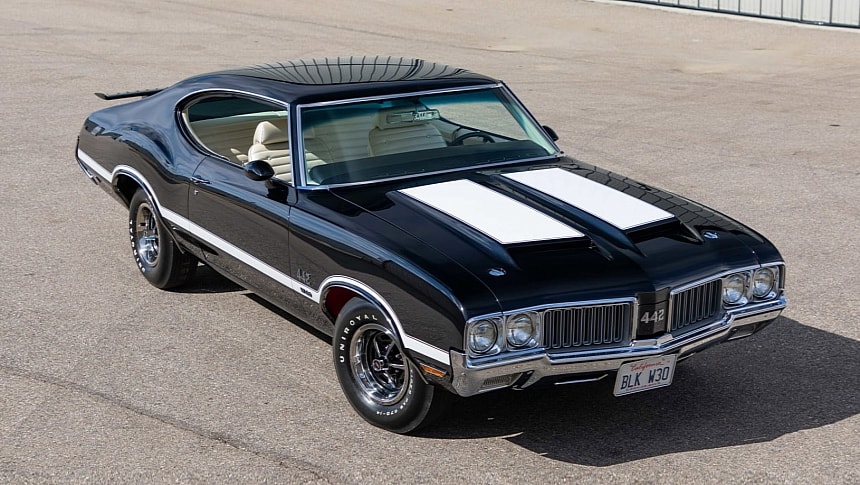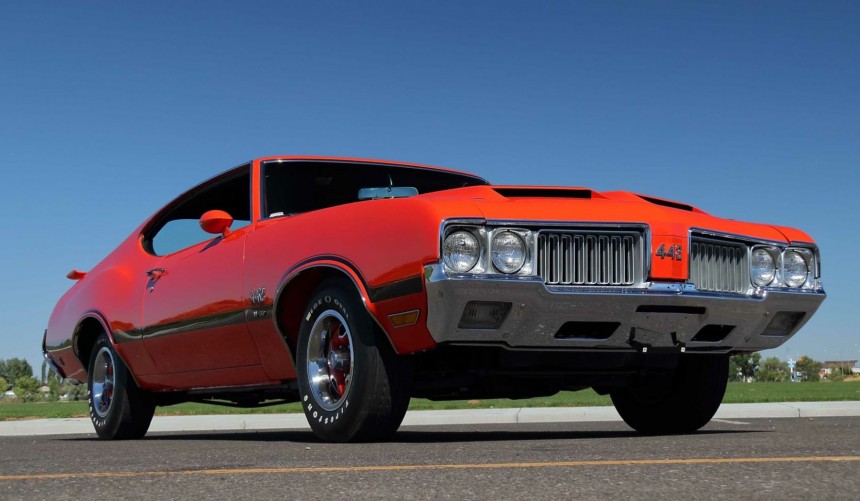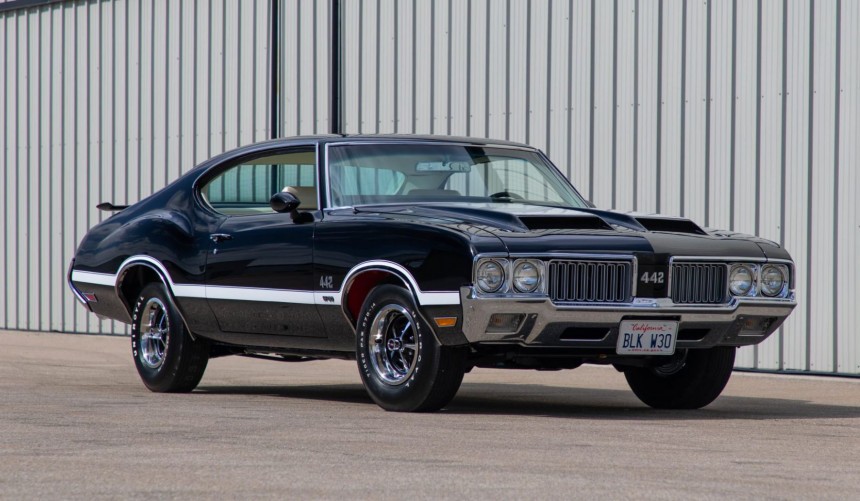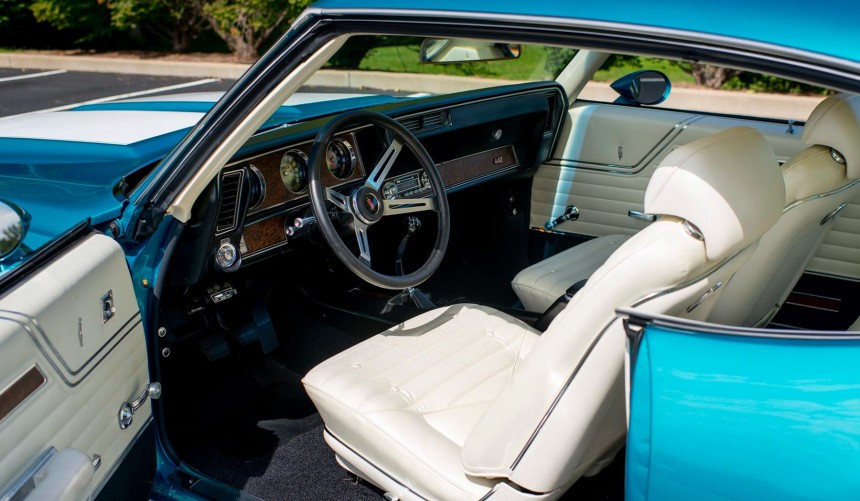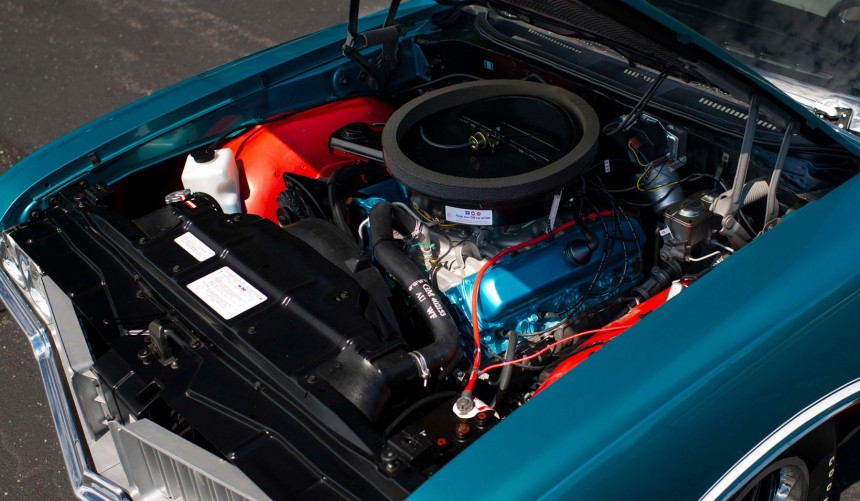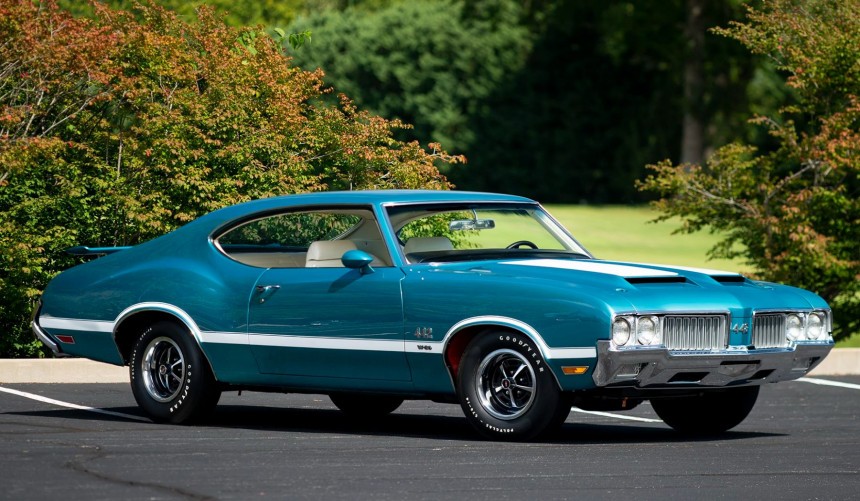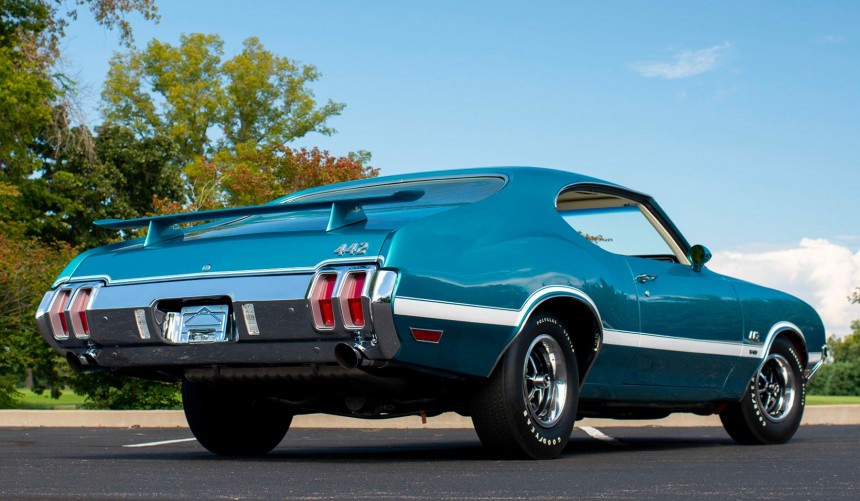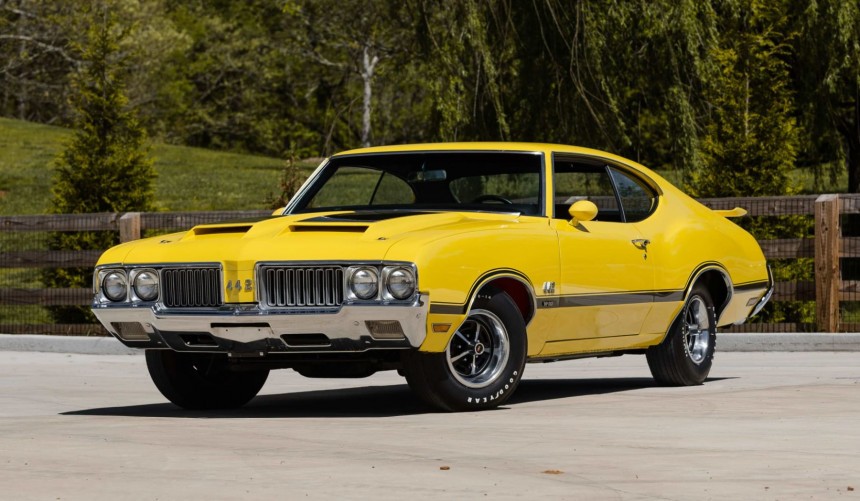Though never as popular as its high-powered Chevelle SS and GTO siblings, the 4-4-2 W-30 combined tire-shredding performance and luxury better than any other muscle car available during the epic 1970 model year.
High-performance, factory-built intermediates started emerging during the first part of the 1960s.
However, when Pontiac introduced the highly popular GTO option for the 1964 model-year LeMans, a fierce horsepower war broke out in Detroit.
In the following years, nearly all other carmakers entered the muscle car battlefield, giving performance enthusiasts a huge variety of tire shredders from which to choose.
The pinnacle of that epic battle for supremacy in the high-performance market came during the 1970 model year when, partially due to GM's decision to lift its self-imposed 400-ci (6.5-liter) ban on intermediate-bound V8s.
Consequently, apart from the HEMI-powered Mopars and FoMoCo's Cobra Jet-equipped machines, GM's A-body intermediates were now available with gargantuan and obscenely powerful engines.
Today, when most enthusiasts talk about the greatest muscle cars of 1970, they usually mention the HEMI 'Cuda and Road Runner, the Chevelle SS 454 LS6, or the Buick GSX Stage 1.
While those models had higher output ratings and were a bit quicker, the often-forgotten Oldsmobile 4-4-2 W30 was not far behind in terms of performance and had one quality that set it apart from its rivals: luxury.
Although Pontiac and Oldsmobile were both part of GM and the latter division developed vehicles that were more focused on an upscale experience rather than performance, the introduction of the GTO in 1964 sparked a fierce rivalry between the two.
Months after the GTO was added to the LeMans' list of optional packages, Olds answered with its own performance-oriented package.
Dubbed 4-4-2, a moniker that hinted at a combination of a four-barrel carb, a four-speed manual, and a dual exhaust, the package was initially available for the Cutlass and F-85.
Secretly yet hastily developed by a small team of enthusiastic Olds engineers, including John Beltz, Dale Smith, and Bob Dorshimer, the 4-4-2 added several performance-oriented upgrades like beefier suspension components, a dual exhaust system and a four-barrel carburated 330-ci (5.4-liter) V8 rated at 310 hp.
While it wasn't as successful as the GTO, the 4-4-2 option was improved in the following years. By 1968, when the entire A-body intermediate lineup was redesigned, it graduated to a separate model status, welcoming a new engine upgrade option called W-30 that added even more performance.
The W-30-equipped 4-4-2 would reach its performance peak two years later as part of the epic 1970 model year.
Similar to its siblings, the Pontiac GTO, Chevy Chevelle SS, and Buick GS, the Olds 4-4-2 received several aesthetic improvements.
Compared to the outgoing model, 1970 4-4-2, available as a Sport Coupes, Holiday Coupe, or convertible, featured vertical bars in the chromed front grille, rectangular parking lights, vertically-finned tail lights, clamshell side mirrors, and a new stripe package.
But unquestionably, the most distinctive feature of Oldsmobile's revised apex predator was the W-30-exclusive fiberglass twist-lock hood with functional twin scoops.
Other distinctive visual features were the optional rear spoiler and the red inner front fenders, manufactured from plastic to reduce weight.
Though it was unquestionably a thoroughbred muscle car, in typical fashion, Oldsmobile didn't cut any corners when it came to the upscale feel of the flagship performance model's interior.
An optioned-out 1970 4-4-2 W-30 was equipped with high-end amenities such as beautifully upholstered high-back bucket seats with headrests, Tic-Toc-Tach, chrome-ringed gauges, woodgrain inserts, or a pushbutton AM/FM radio.
Its upscale interior, which many have dubbed the finest of any 1970 performance-oriented intermediate, coupled with the aggressive-looking body, made the 4-4-2 W-30 the ultimate gentleman's muscle car.
With GM's displacement ban now gone, Oldsmobile was free to offer its largest V8 as standard in the 4-4-2 for the very first time.
Introduced in 1968 as the Rocket 455, the V8 actually displaced 454.6 cubic inches (7.4 liters), producing 365 hp and 500 lb-ft (680 Nm) in standard form.
However, those who wanted the most powerful 4-4-2 that money could buy often chose the optional W-30 package that added revised cylinder heads, a hotter camshaft, an aluminum intake manifold, a low-restriction air cleaner, and, last but not least, an improved four-barrel carb.
According to the brochure, the W-30 package only added five additional horses, but in reality, the performance gain was more generous.
As it was customary back then, carmakers purposefully underrated their most potent engines to keep insurance premiums at bay, and Olds was no exception.
When put on a dyno, the 4-4-2's W-30-spec 455 often yielded well over 400 hp.
That was evidenced by the car's prowess in a straight line. According to an independent test published in the Popular Hot Rodding magazine in April 1970, a bone-stock 4-4-2 W-30 ran the quarter mile in 13.89 seconds at 101.1 mph (162.7 kph).
Although that made it the 10th quickest muscle car of 1970, the slightly heavier W-30 4-4-2 was only 0.77 seconds slower than a Chevelle SS equipped with the 454 LS6 rated at 450 hp.
When it introduced the Rocket 455 in 1968, Oldsmobile only fitted the gargantuan V8 in its full-size models.
Nevertheless, that year, the GM division also began a partnership with famed shifter manufacturer Hurst, which gave birth to the Hurst/Olds.
An intermediate based on the 4-4-2, the Hurst/Olds was available with the big 455 in 1968 and 1969. However, to dodge the GM displacement ban, the engines and body-in-whites were sent separately to Hurst Performance, which handled the powertrain assembly.
In conclusion, while the 1970 4-4-2 was the first Olds intermediate to leave the factory with a Rocket 455 under the hood, it wasn't the first Olds intermediate to be powered by one.
Despite being one of the best all-around muscle cars of 1970, the 4-4-2 W-30 didn't sell in huge numbers. That was due to its slightly heftier price tag, as well as its factory output ratings.
When the 1970 model year ended, Oldsmobile's total 4-4-2 sales amounted to 19,330 units. Of those, only 3,100 left the factory with the W-30 option.
Few of them have survived, and even fewer are highly original, low-mileage examples that benefited from a frame-off restoration.
One such mint 4-4-2 W-30 can go for well over the $100,000 mark in today's classic muscle car collector's market.
While knowledgeable collectors and hard-core muscle car fanatics still remember and appreciate the 1970 4-4-2 W-30, this epic tire-shredder is still forgotten and underrated by many.
For more on arguably the coolest gentleman's muscle car ever created, we recommend watching the Rare Cars YouTube video below which inspired this article.
However, when Pontiac introduced the highly popular GTO option for the 1964 model-year LeMans, a fierce horsepower war broke out in Detroit.
In the following years, nearly all other carmakers entered the muscle car battlefield, giving performance enthusiasts a huge variety of tire shredders from which to choose.
The pinnacle of that epic battle for supremacy in the high-performance market came during the 1970 model year when, partially due to GM's decision to lift its self-imposed 400-ci (6.5-liter) ban on intermediate-bound V8s.
Consequently, apart from the HEMI-powered Mopars and FoMoCo's Cobra Jet-equipped machines, GM's A-body intermediates were now available with gargantuan and obscenely powerful engines.
Today, when most enthusiasts talk about the greatest muscle cars of 1970, they usually mention the HEMI 'Cuda and Road Runner, the Chevelle SS 454 LS6, or the Buick GSX Stage 1.
While those models had higher output ratings and were a bit quicker, the often-forgotten Oldsmobile 4-4-2 W30 was not far behind in terms of performance and had one quality that set it apart from its rivals: luxury.
A brief history of the 4-4-2
Months after the GTO was added to the LeMans' list of optional packages, Olds answered with its own performance-oriented package.
Dubbed 4-4-2, a moniker that hinted at a combination of a four-barrel carb, a four-speed manual, and a dual exhaust, the package was initially available for the Cutlass and F-85.
Secretly yet hastily developed by a small team of enthusiastic Olds engineers, including John Beltz, Dale Smith, and Bob Dorshimer, the 4-4-2 added several performance-oriented upgrades like beefier suspension components, a dual exhaust system and a four-barrel carburated 330-ci (5.4-liter) V8 rated at 310 hp.
While it wasn't as successful as the GTO, the 4-4-2 option was improved in the following years. By 1968, when the entire A-body intermediate lineup was redesigned, it graduated to a separate model status, welcoming a new engine upgrade option called W-30 that added even more performance.
The W-30-equipped 4-4-2 would reach its performance peak two years later as part of the epic 1970 model year.
Oldsmobile's most aggressive-looking muscle car
Compared to the outgoing model, 1970 4-4-2, available as a Sport Coupes, Holiday Coupe, or convertible, featured vertical bars in the chromed front grille, rectangular parking lights, vertically-finned tail lights, clamshell side mirrors, and a new stripe package.
But unquestionably, the most distinctive feature of Oldsmobile's revised apex predator was the W-30-exclusive fiberglass twist-lock hood with functional twin scoops.
Other distinctive visual features were the optional rear spoiler and the red inner front fenders, manufactured from plastic to reduce weight.
Arguably the finest interior of any 1970 muscle car
An optioned-out 1970 4-4-2 W-30 was equipped with high-end amenities such as beautifully upholstered high-back bucket seats with headrests, Tic-Toc-Tach, chrome-ringed gauges, woodgrain inserts, or a pushbutton AM/FM radio.
Its upscale interior, which many have dubbed the finest of any 1970 performance-oriented intermediate, coupled with the aggressive-looking body, made the 4-4-2 W-30 the ultimate gentleman's muscle car.
Powered by the largest Olds big-block V8
Introduced in 1968 as the Rocket 455, the V8 actually displaced 454.6 cubic inches (7.4 liters), producing 365 hp and 500 lb-ft (680 Nm) in standard form.
However, those who wanted the most powerful 4-4-2 that money could buy often chose the optional W-30 package that added revised cylinder heads, a hotter camshaft, an aluminum intake manifold, a low-restriction air cleaner, and, last but not least, an improved four-barrel carb.
According to the brochure, the W-30 package only added five additional horses, but in reality, the performance gain was more generous.
Underrated performance
When put on a dyno, the 4-4-2's W-30-spec 455 often yielded well over 400 hp.
That was evidenced by the car's prowess in a straight line. According to an independent test published in the Popular Hot Rodding magazine in April 1970, a bone-stock 4-4-2 W-30 ran the quarter mile in 13.89 seconds at 101.1 mph (162.7 kph).
Although that made it the 10th quickest muscle car of 1970, the slightly heavier W-30 4-4-2 was only 0.77 seconds slower than a Chevelle SS equipped with the 454 LS6 rated at 450 hp.
It wasn't the first Olds intermediate powered by the Rocket 455
Nevertheless, that year, the GM division also began a partnership with famed shifter manufacturer Hurst, which gave birth to the Hurst/Olds.
An intermediate based on the 4-4-2, the Hurst/Olds was available with the big 455 in 1968 and 1969. However, to dodge the GM displacement ban, the engines and body-in-whites were sent separately to Hurst Performance, which handled the powertrain assembly.
In conclusion, while the 1970 4-4-2 was the first Olds intermediate to leave the factory with a Rocket 455 under the hood, it wasn't the first Olds intermediate to be powered by one.
One of the rarest, most sought-after Oldsmobile models
When the 1970 model year ended, Oldsmobile's total 4-4-2 sales amounted to 19,330 units. Of those, only 3,100 left the factory with the W-30 option.
Few of them have survived, and even fewer are highly original, low-mileage examples that benefited from a frame-off restoration.
One such mint 4-4-2 W-30 can go for well over the $100,000 mark in today's classic muscle car collector's market.
While knowledgeable collectors and hard-core muscle car fanatics still remember and appreciate the 1970 4-4-2 W-30, this epic tire-shredder is still forgotten and underrated by many.
For more on arguably the coolest gentleman's muscle car ever created, we recommend watching the Rare Cars YouTube video below which inspired this article.
